Tianjin Shipping Index(Mar.19-Mar.23)
I. Tianjin Shipping Index (TSI)
In Week 12, 2018 (Mar.19-Mar.23), Tianjin Container Freight Index (TCI) kept decreasing. Tianjin Bulk Freight Index (TBI) decreased slightly. Tianjin Domestic Container Freight Index (TDI) increased with fluctuation. Tianjin Shipping Index (TSI) fluctuated slightly. The TSI closed at 583.62 points with a slight increase of 0.03% from Mar.16 (the last release day of Week 11). The TSI trend is as follows:
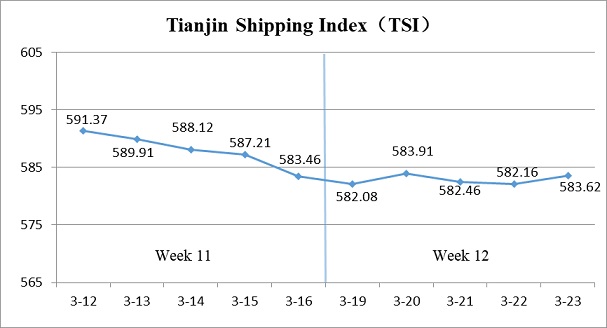
The chart above shows the trends of TSI from Mar.12 to Mar.23. The value of TSI in Week 12, 2018 is as follows:
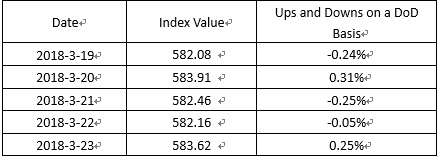
II. Tianjin Container Freight Index (TCI)
In Week 12, 2018 (Mar.19 to Mar.23), the trend of TCI is as follows:
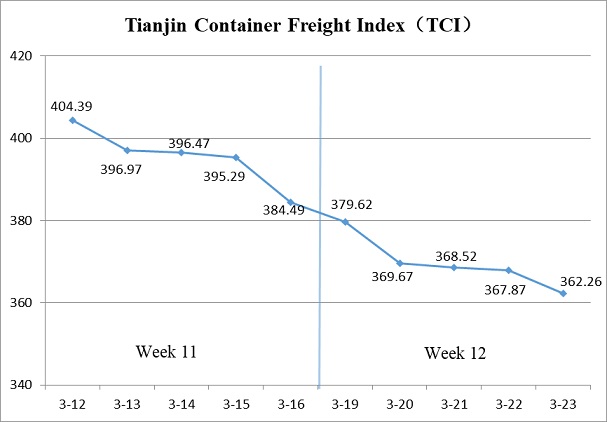
In week 12, the TCI kept decreasing.
From Mar.19 to Mar.20 (Mon. to Tue.), the freight rates in European route, Mediterranean route, North American route, South American route and India-Pakistan route decreased overall. The TCI decreased rapidly by 3.85% on two consecutive release days. From Mar.21 to Mar.23 (Wed. To Fri.), the freight rates in European route, Mediterranean route, North American route, South American route and India-Pakistan route kept the decrease trend. The TCI kept decreased with a narrower range. The decrease was 2.00% on three consecutive release days.
The TCI closed at 362.26 points with a decrease of 22.23 points (5.78%) from Mar.16 (the last release day of Week 11).
The TCI index value saw several up and down on a day-on-day basis are as follows:
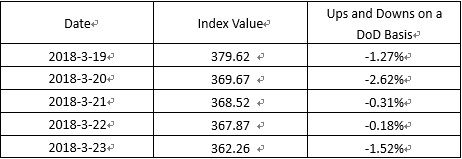
European/Mediterranean route Cargo volume hovered around a low level. The ship owners put more ships on the market at the end of the week. Transport capacity became larger and the freight rates presented a weak trend the whole week. The freight indices in European route, Mediterranean East route and Mediterranean West route decreased 5.53%、5.33% and 3.55% on a week on week basis.
North American route The increase of cargo volume slowed down. Transport capacity was on a high level. It has become a mainstream that the freight rates were reduced to guarantee berth utilization ratio. The freight indices in North American West coast route and North American East coast route decreased 7.06% and 5.77% this week.
South American route The overall transport capacity was lower than that of last year. Competition for cargo volume was fierce. The ship owners’ pressure to collect cargo became larger. The freight rates decreased markedly. The freight indices in South American West Coast route, South American East Coast route and Central South American route decreased 21.66%、10.85% and 10.58% this week.
India-Pakistan route Since 2018, the freight rates started to increase pressured by cost. Before Spring Festival, the freight rates increased 60%. But the high freight rates can not last long because the demand was week. After Spring Festival, the freight rates decreased gradually. This week, it presented a faster decrease trend and the freight indices decreased 17.36%.
III. Tianjin Bulk Freight Index (TBI)
Week 12, 2018 (Mar.19 – Mar.23), Tianjin Bulk Freight Index (TBI) is shown as follows:
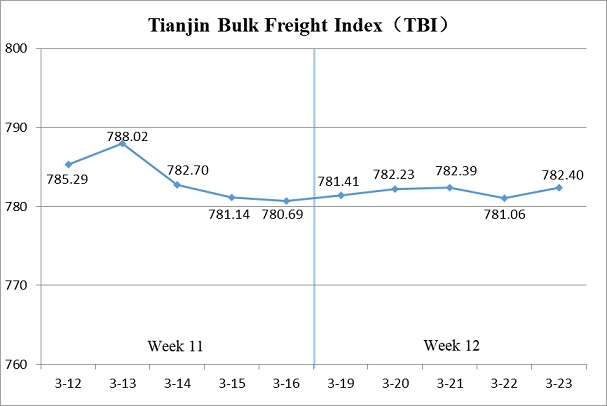
In week 12, the TBI shocked narrowly.
From Mar.19 to Mar.21 (Mon. to Wed.), the freight rate of mineral ore decreased slightly but the freight rates of coal and grain increased slightly, which led the TBI to increase slightly for three successive release days. The total increase was 0.22%. Then, the freight rates of coal and grain continued to increase slightly and the decrease of the freight rate of mineral ore extended, which led the TBI to decrease 0.17% on a day-on-day basis on Mar.22 (Thu.).
On Mar.23 (Fri.), the freight rates of coal and grain kept stable and the freight rate of mineral ore increased. TBI ended at 782.40 points with an increase of 1.71 points (0.22%) from Mar.16 (the last release day of week 11).
TBI index value saw several ups and downs on a day-on-day basis, which is shown as follows:
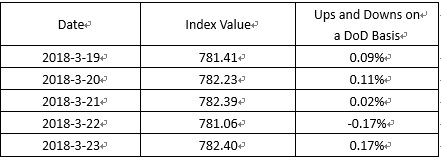
TBCI kept increasing this week. TBCI ended at 682.46 points with an increase of 13.77 points (2.06%) from Mar.16 (the last release day of week 11). Coal shipment demand was stable this week and the trends of the freight rates of different routes mixed. For the Panamax market, carriers were in short supply in the Pacific and the freight rate of the DBCT to Tianjin route increased again and the total increase was about 4%. For the Capesize market, the freight rate of Hay Point to Qingdao route decreased with shocks and the total decrease was about 1%.
TBGI increased continuously this week. It ended at 707.64 points with an increase of 2.21 points (0.31%) from Mar.16 (the last release day of week 11). The South American grain market was active, attracting a lot of carriers which provided support for the grain shipment market, and the freight rate increased slightly. The freight rate of South America to Tianjin route increased 0.4%. The freight rate of US Gulf to Tianjin route increased 0.25% and the freight rate of West America to Tianjin route increased 0.26%.
TBMI decreased continuously this week and it increased slightly at the end of the week. It ended at 957.11 points with a decrease of 10.83 points (1.12%) from Mar.16 (the last release day of week 11). For the iron ore market, international iron ore price was low and inventories in domestic ports were high, as a result, iron ore import shipment market was not active and the freight rate decreased further. Bad weather affected port operations in Western Australia and market enquiries were less. The freight rate of West Australia to North China decreased over 1.3%. The freight rate of Brazil to Tianjin route decreased about 2.5%. As for nickel ore, the deal of nickel ore was active and it led the freight rate of Surigao to Tianjin route to increase over 1%.
IV. Tianjin Domestic Container Freight Index (TDI)
Week 12, 2018 (Mar.19-Mar.23), the trend of Tianjin Domestic Container Freight Index (TDI) is shown in the chart below:
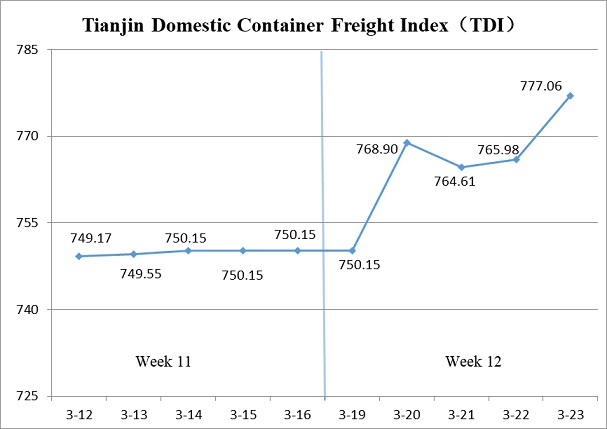
Compared with the TDI in Week 11, the TDI in Week 12 rocketed.
On Mar.19 (Mon.) , both the Inward Index and the Outward Index kept stable, compared with that on Mar.18 (the last release day of Week 11), so the TDI remained the same(750.15 points). On Mar.20 (Tues.), though the Inward Index did not change, the Outward Index leaped, which brought the sudden increase of the TDI (2.50%). On Mar.21 (Wed.), the Outward Index kept steady, but the Inward Index dropped, which led to the decline of the TDI (0.56%). From Mar.22 (Thur.) to Mar.23 (Fri.), both the Inward Index and the Outward Index soared and the TDI rose again(1.63%), finally being closed at 777.06 points, with a growth of 26.91 points (3.59%), compared with that on Mar.16 (the last release day of Week 11).
The value of TDI ups and downs on a day-on-day basis is shown as follows:
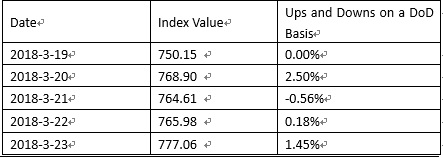
Tianjin Domestic Container Outward Freight Index (TDOI) dramatically increased this week. It was closed at 919.26 points on Mar.23 (Fri.), experiencing a sharp rise of 45.77 points (5.24%), compared with that on Mar.16 (the last release day of Week 11). In detail, the freight rate indices of three routes differed from each other this week. As for Tianjin-Quanzhou route, the freight rate index dipped 1.42% on a week-on-week basis due to some ship companies’ reducing price that the shortage of goods in market brought. By contrast, in terms of Tianjin-Shanghai and Tianjin-Guangzhou routes, the freight rate indices respectively increased 4.24% and 6.93% on a week-on-week basis because some ship owners levied fuel oil surcharge. the demand and supply was relatively balanced this week, so the had to wait and see, further bringing steady freight rate index.
Tianjin Domestic Container Inward Freight Index (TDII) also went up this week, eventually being closed at 634.85 points on Mar.23, with an increase of 8.05 points (1.28%), compared with that on Mar.16 (the last release day of Week 11). This week, the trends of the freight rate index of the three routes were totally different. The freight rate index of Quanzhou-Tianjin route plummeted 11.85%, compared with that of last week. However, the freight rate index of Guangzhou-Tianjin route continued rising (5.54%). The freight rate index of Shanghai-Tianjin route kept steady.
HEADLINES
- Do shipping markets want Biden or Trump for the win?
- All 18 crew safe after fire on Japanese-owned tanker off Singapore
- Singapore launching $44m co-investment initiative for maritime tech start-ups
- Cosco debuts Global Shipping Industry Chain Cooperation Initiative
- US warns of more shipping sanctions
- China continues seaport consolidation as Dalian offer goes unconditional